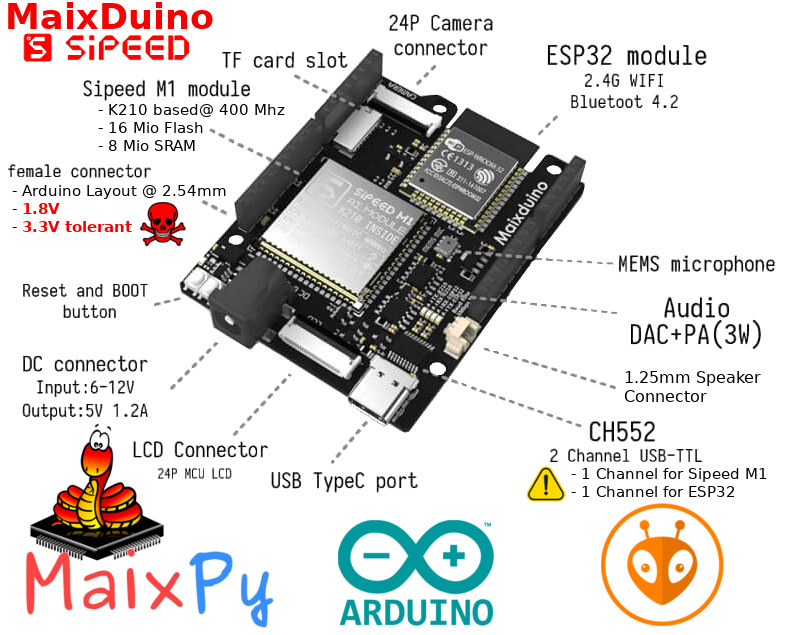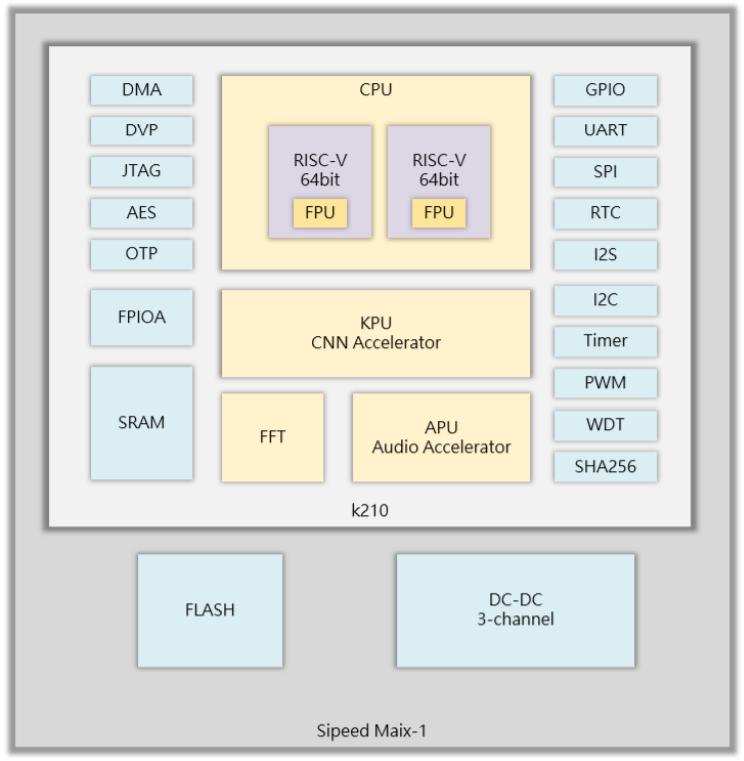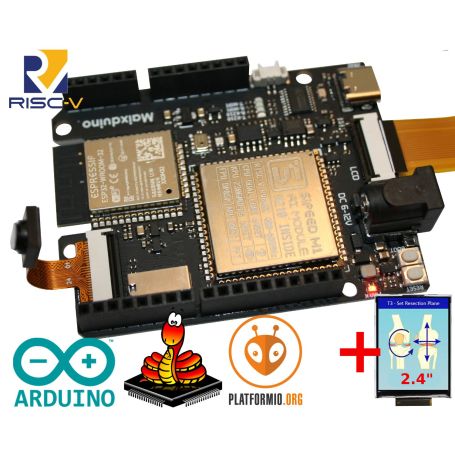Maixduino AI Development Kit K210 RISC-V AI + lOT ESP32
MaixDuino - the K210 RISC-V development kit with display
- Sipeed M1 (K210) 64 bits @ 400 Mhz
- 16 Mo de Flash
- 8 Mo SRAM
- ESP32 for Wireless connectivity
- AI capabilities
- 2.4" display (ST7789)
- Camera (GC0328)
- PlateformIO / Arduino IDE support
- MicroPython pre-installed (MaixPy)
Payments are secured by LyraCollect, a French payment collection company.
It is possible to delivered to your home, to a pick-up point or picked up by appointment at MCHobby
We prepare, pack and ship your orders with great respect and care.
K210 RISC-V development plateform supporting MicroPython / Arduino IDE / Plateforme IO
The MaxDuino is a board based the Sipeed M1 processor. Under the processor cover, there is the famous K210 from Kendryte, a RISC-V Artificiel Intelligence dual core fitted with the required parts (likes regulator, Flash, etc) under a metal cover.
So the Maixduino AI development board is an Arduino UNO form factor fitted with the Sipeed M1 AI (Artificial Intelligence) module and ESP32 module for WiFi and Bluetooth connectivity. The ESP32 also offers the Analog capabilities to the MaixDuino board.

The K210 is a 64 bits dual-core processor chip with independent FPU, 8 MB on-chip SRAM, 64 bits CPU 400 Mhz adjustable frequency, double-precision FPU supporting multiplication, division, and square root operation.
Maixduino AI Development Board is equipped with neural network hardware accelerator KPU, voice processing unit (APU), programmable IO array (FPIOA/IOMUX), and Fast Fourier Transform Accelerator. In the AI processing, K210 can perform operations such as convolution, batch normalization, activation, and pooling. At the same time, the pre-processing of voice direction scanning and voice data output can also be performed.

The on-board wireless module the MaixDuino is an ESP32-WROOM-32 with dual-core ESP32 Xtensa LX6 processor, 2.4GHz 802.11.b/g/n WiFi 4 and Bluetooth 4.2 LE connectivity. The ESP32 is pre-programmed to work with the Sipeed M1 and offering the required service. However, the ESP32 serial port is also exposed on the USB-C connector, so you can update the firmware or write your own one.
What's more with the MaixDuino:
- DVP connector: the Digital Video Port is a parallel bus interface wired directly to the microcontroler. It is designed for the camera.
- Display connector: That SPI allows you to connect the a LCD screen. MaixDuino may be shipped with a ST7789 based 2.4" LCD (see specs here). This is a 320x240 pixels in 262K color LCD.
- Microphone: built-in MEMS microphone (MSM261S4030H0)
- Audio Output: the DAC TM8211 is an I2S audio.
- Audio amplifier: the NS4150 ensure an audio output of 3W power.
- USB-C port: USB 2.0 Device port for powering and programming
- Arduino UNO header: Digital, I/Os, PWM, I2C, UART, 6x analog inputs and power signals.
The MaixDuino would do a great job in the following projets: smart home (automated vacuum cleaner), Smart speaker, medical device, Industry 4.0, agriculture and education.
Two USB-Serial lines
This may appears quite confusing at first but the MaixDuino do open TWO Usb-Serial line when connected to a computer.
Thanks to the dual channel CH522 chip the board allow the computer to connect the two microcontroler fitted on the board!
The first channel targets the ESP32 which is pre-programmed and should not be updated.
The second channel targets the Sipeed M1 (K210) user processor. The K210 line is the connection to be used when programming the MaixDuino board with the Arduino IDE/Plateform IO/MicroPython MaixPy.
MicroPython MaixPy preloaded
MaixPy is a version of MicroPython developped for Maix's based board (so a MicroPython version for RISC-V, plus précisement pour K-210).
The board is preloaded with MaixPy, just connect a terminal to the USB-Serial port of the Sipeed processor and start to key-in python command on the MicroPython REPL. You can also use your favorite tool to transfert files and data to the micropython running on the board.
Remember to select the right USB-Serial port of the both exposed by the board.
3.3V Tolerant
The shape and pins are compatible with Arduino UNO R3 but the voltage level is not compatible, which requires great attention, otherwise the board can be damaged. Maixduino supports 3.3V and 1.8V levels, and the pins are divided into several BANKs, each BANK can be set to a voltage of 1.8V or 3.3V by software, However, these pins are not 5V tolerated. Therefore, when using the peripheral device of Arduino, be careful not to short the 5V to the pin or RST (1.8V) pin.
Technical details
- CPU: RISC-V Dual Core 64bit, with FPU; 400MHz standard frequency (overclockable)
- 16 Mio of Flash
- 8 Mio of SRAM
- Built-in neural network processor
- Connector: compatible with Arduino interface, TF card slot, speaker port
- Wireless: support 2.4G 802.11.b/g/n and Bluetooth 4.2
- Audio: MEMS microphone, 3W speaker output
- 8 Bit (256 levels) adjustable color, 5Bit (32 levels) brightness adjustment
- DVP Camera Interface: 24P 0.5mm FPC connector, support 0V2640, 5640, 0V7740, etc.
- LCD Interface: 24P 0.5mm FPC connector; support 8bit MCU LCD
- ESP32 Module: support 2.4G 802.11.b/g/n
- 802.11 n (2.4 GHz) speed reaches 150 Mbps
- Bluetooth v4.2 full specification, including traditional Bluetooth (BR / EDR) and Bluetooth Low Energy (BLE)
- Development Environment: support for Arduino IDE, MaixPy IDE, OpenMV IDE
- Peripherals: I2C, SPI, I2S, WDT, TIMER, RTC, UART, GPIO etc.
- Power Input: USB Type-C (6~12V
- Operating Temperature: -30~85ºC
- MaixDuino Schematic (pdf)
Content
For each order, you will receive the Kit containing: Maixduino board controller, 2.4"LCD screen, GC0328 camera.
Tutorials
- MaixDuino documentation (Maixduino.sipeed.com, English)
includes the support for Arduino & Plateform IO . - MaixPy documentation (Sipeed Wiki, English)
CLICK on the "MaixPy" icon THEN switch to english. - MaixPy - MicroPython for Maix board series (Github, English)
- Other ressources about MaixPy (sipeed.com)
- Product Data (GitHub)
Zip file containing Arduino core & libraries for the board











